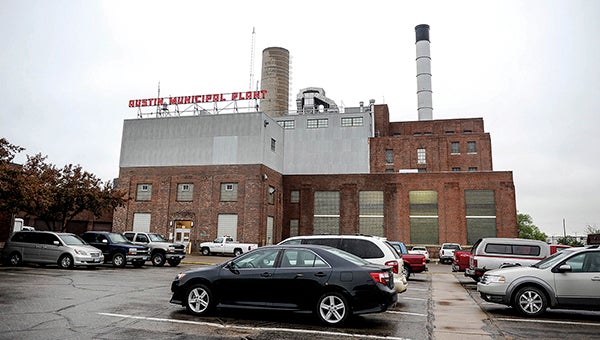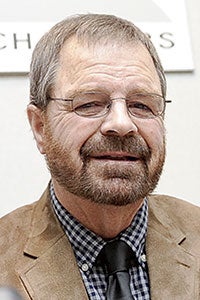Nearing a final goal? City, YMCA, Vision 2020 discuss fees for rec center
Published 10:34 am Tuesday, May 10, 2016

Questions remain as a final offer was made on the downtown Austin Municipal Plant Monday night.
— Eric Johnson/photodesk@austindailyherald.com
After nearly four years of talks, plans, meetings and, more recently, tough negotiations, the Austin City Council will likely see a final offer on the proposed $35 million Austin Community Recreation Center next week.
But many questions still remain on the city of Austin’s participation in the project, especially on a proposed operating agreement for the YMCA to run community portions of the facility and on potential daily passes for the YMCA portions of the facility.
At a public Vision 2020 Austin Community Recreation Center committee meeting in the Town Center building on Monday, YMCA, city and Vision 2020 leaders discussed proposals for day pass fees. Though many numbers were discussed, the final offer was for $8 per visit with maximum of four visits per year for access to the entire facility, though public portions like an indoor park and Youth Activity Center would still be open to the community.
Mayor Tom Stiehm said the City Council will discuss the offer in a May 16 work session, though the council may postpone voting.
Questions on passes
Vision 2020’s goal is to build a rec center that would likely be jointly operated by the city and YMCA at the former downtown Austin Municipal Plant.
The City Council has expressed interest in participating in the project, but it wants to make sure it’s a community rec center with amenities available to non-Y members.
Plans call for part of the facility be a new YMCA that would only be accessible to Y members, while other parts would be publicly accessible rec center spaces, though many details are still being worked out. The facility would likely feature things like an indoor playground, a family aquatic center, community spaces, gyms, a gymnastics facility, workout rooms, a running track and more.
Open community portions would include pieces like the indoor playground, the Youth Activity Center and some of the meeting rooms. The walking track could be available to nonmembers for four hours a day, two in the morning and two at night.
But on Monday, city and YMCA leaders expressed concerns over day passes for the non-public, YMCA portions of the facility. While Stiehm and Austin City Council members voiced concerns about the affordability of day pass fees and accessibility for the public, YMCA Executive Director Tedd Maxfield voiced concerns about losing memberships to day passes, which could affect the facility’s budget.
In fact at the beginning of the meeting, Stiehm said the city and YMCA were at an impasse.
“We have made offers, offers, offers,” Stiehm said. “You guys have said, from day one, [it] has to be affordable.”
But discussions soon picked up on the passes.
The YMCA first proposed $12.50 day passes with unlimited uses, but Stiehm and the city countered with $8 and offered $100,000 more to make up the difference from $12.50 — that would be in addition to the $200,000 the city already proposed to pay in annual operations for the Y to run the public portions if the deal goes through.
City leaders also asked the YMCA if the pool and gym fee could be separated, such as $12.50 for the gym and $8 for the pool.
The Y eventually countered with $8 per visit fee for four visits per year, which was heavily discussed at Monday’s meeting.
“The challenge is it eats into our membership revenue,” Maxfield said. “It’s not about the difference between $8 and $12 and the revenue difference between those two. It’s the difference between if I can come for … dollars per time, whenever I want to, why would I join?”
Maxfield said he hopes to eventually reduce membership rates and thereby reduce day pass fees as well, but they can’t decide that without knowing what the operating costs are going to be and what the economic climate is going to be then.
Maxfield said the membership revenue makes up about 60 percent of the Y’s overall income. He also pointed out most members who pay $50.50 per month for access to the whole facility, only go about four times a month and pay that fee because “they want to have the facilities available to them when they want to use them.”
“And if they can come in and plunk down $8, for those four times a month, then why ever would they join?” he asked.
City Council member Janet Anderson said that is true for herself and her husband, but she added they probably wouldn’t drop their memberships if the new facility is built.
“I’m sure I’m not the only person in that scenario,” Anderson said. “… If I did the per day deal after a few months, I’d go, ‘Heck I could have a membership,’ so why would I not do that? If I enjoyed the experience and it was a good thing for me, for my family.”
However, Anderson at one point read the rec center committee’s mission statement and questioned if the deal discussed Monday truly made for a safe and affordable facility.
Stiehm agreed that reasonable fees could potentially impact Y memberships, which they could try to limit the amount of visits; however, he also noted the Y projected a 70 percent increase in memberships.
But Maxfield noted the four daily passes are meant to be a trial period for people to determine if people want to join the Y.
“They can come as many times they want, they just have to join the Y,” Maxfield said. “Everybody in the community can join the Y.”
But Stiehm said that’s the biggest criticism of the project.
“People tell us it’s not going to be a rec center, it’s just going to be a bigger Y,” Stiehm said.
Vision 2020 Rec Center Committee Co-Chair Matt Cano added if the city had a bigger appetite for more than $200,000 to $300,000 a year, it could pay more per year to make more amenities open as part of the facility’s public portion.
But Anderson noted the city wants a balance.
Cano said the committee and the Y have outlined a business plan and know the tentative figures for the operational cost.
“Whoever’s managing it, those costs are there, they could be 100 percent accurate. … There’s probably about a 5-10 percent variance inside there,” Cano said. “But at the end of the day, it’s $2.2 million, it’s just a matter of who pays for it, or how does it get paid for? And that’s really where we’re at right now.”
But Anderson added the city will face additional costs if the project moves forward. She said the city would also have to do a traffic study and possibly add a stoplight along Fourth Avenue Northeast, which costs additional money.
A community boost
City leaders see the proposed $35 million rec center as an amenity that might help make Austin more attractive for potential employees and employers.
“We spent four years on this initiative to make our community a better community,” Cano said. “This is one piece that we strongly feel is going to be better for the community. At the end of the day, it’s going to be our city that benefits from the rec center.”
“We’re going to have a healthier community, a happier community,” he added.
However, Council member Steve King said the poverty rate was 13 percent in 2011 and it’s 20 percent in 2016. While the rec center could help, affordability is still a question.
“We are sprinting to the bottom,” King said. “We have enormously low taxes; that’s not it. It is our amenities. It is our perception of what the city has to offer. I’d love to take this gift of $35 million, say thank you very much, let’s build a rec center and collaborate nicely with the Y, but it comes to affordability.”
The Hormel Foundation has pledged $25 million to the $35 million project to acquire and build the rec center, Hormel Foods Corp. has pledged $5 million, and the final $5 million would be raised in a capital campaign.
Stiehm said the city is fortunate to have The Hormel Foundation.
“I think they’re sticking their neck out a mile for us on this and it’s an opportunity we’d hate to lose out on,” Stiehm said. “We’re just trying to find common ground.”
Both Maxfield and Stiehm said they’ve heard funders like The Hormel Foundation and Hormel Foods Corp. indicate the project will move ahead if the city doesn’t approve the operating agreement.
If that were to happen, the waterpark could be smaller and the indoor playground may not be available to non-members, Maxfield said.






